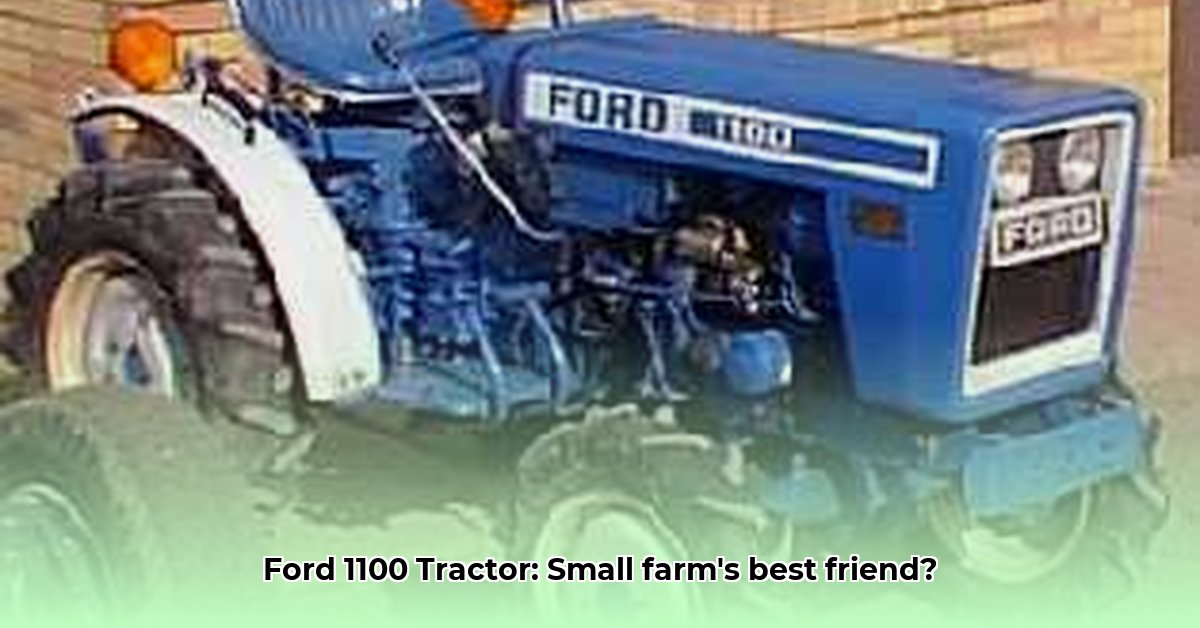
The Ford 1100 tractor, a familiar sight on farms from the late 1970s and early 1980s, presents a compelling case study in the evolution of agricultural technology and its intersection with sustainable practices. This retrospective review examines the Ford 1100's strengths and weaknesses in the context of modern, environmentally conscious farming, offering insights for various stakeholders. For more information on Ford tractors, check out this helpful resource.
The Ford 1100: A Historical Perspective
Produced between 1979 and 1983, the Ford 1100 was a popular choice for smaller farms due to its compact size and relatively manageable weight (approximately 1231 to 1344 pounds). This lighter weight minimized soil compaction, a significant benefit for soil health and long-term productivity. Fuel efficiency was also a positive aspect, estimated at 3.5 to 3.7 gallons per hour. However, its modest 12.5 horsepower engine limited its versatility and power output, leading to longer working hours for comparable tasks. Its reliance on diesel fuel also presents a significant challenge in the context of contemporary sustainable agricultural practices.
Sustainability Assessment: A Modern Lens
The Ford 1100’s lighter weight remains a significant advantage in promoting soil health, minimizing compaction, and improving water infiltration and nutrient uptake crucial to sustainable agriculture. However, its lower horsepower necessitates increased operational time compared to more powerful modern tractors. While its fuel economy was notable for its time, it pales in comparison to the advancements in fuel efficiency of modern tractors. Furthermore, its reliance on diesel fuel, a fossil fuel source, directly opposes modern sustainable practices focused on reduced carbon emissions. Could a solution be to explore the possibility of using biofuels in older tractors like the Ford 1100? This would be a fascinating area for research and extension services.
Comparison with Modern Alternatives
To accurately gauge the Ford 1100's suitability for modern sustainable farming, a comparison with today’s compact tractors is vital. The following table highlights key differences:
| Feature | Ford 1100 (1979-1983) | Modern Compact Tractor (Example) |
|---|---|---|
| Horsepower | 12.5 | 25-40+ |
| Fuel Type | Diesel | Diesel, Biodiesel, Electric, LPG |
| Fuel Efficiency (GPH) | 3.5-3.7 | 2-4 (variable by fuel type) |
| Emissions | High | Significantly Lower |
| Operating Cost | Moderate | Variable (higher initial cost, potentially lower running costs with alternative fuels) |
| Versatility | Limited | High (Attachments & Implement Options) |
Modern compact tractors offer significantly increased horsepower, broader implement compatibility, and a wider range of fuel options, including biodiesel and even electric variations. While initial investment costs are higher for these modern tractors, the long-term operational efficiency, reduced emissions, and environmental benefits may outweigh these upfront costs for many farmers.
Actionable Insights for Key Stakeholders
The Ford 1100's role in modern sustainable agriculture necessitates a nuanced perspective, depending on the stakeholder:
Small-Scale Farmers: The Ford 1100 might suffice for limited tasks on smaller properties with manageable maintenance costs. However, for efficiency and sustainability gains, newer, more efficient models are generally recommended.
Equipment Dealers: Maintaining and servicing older tractors addresses existing customer needs, but promoting newer, fuel-efficient and versatile models is crucial for fostering sustainable practices and business growth. Offering trade-in programs could further encourage the transition.
Researchers: Analyzing the Ford 1100's performance in its historical context provides valuable data on the evolution of tractor technology and aids in developing future sustainable designs.
Policymakers: Implementing policies that incentivize the adoption of fuel-efficient and sustainable agricultural equipment through subsidies, tax breaks, and educational initiatives is paramount to promoting a greener agricultural sector.
Conclusion: A Legacy, But Not a Future
The Ford 1100 represents a significant chapter in agricultural history. Its compact size and (for its time) efficient fuel consumption are noteworthy. However, its limited power and reliance on fossil fuels limit its relevance to the demands of modern sustainable agriculture. While it may still have a niche role in specific situations, the future of sustainable farming undeniably lies in more powerful, versatile, and environmentally friendly machinery. The Ford 1100's legacy is secure, but its future in mainstream sustainable agriculture is likely limited.